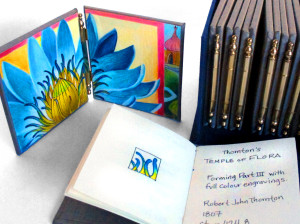What is ‘PERFECT’?
Is it when the grid is straight?
When the edges line up?
When all the colour stays inside the lines?
Maybe. But not necessarily.
I often watch students experience anxiety as they work through a new process, cut into new materials or make their first marks onto a clean white page. They say things like, ‘I’m so nervous – I want it to be PERFECT.’ What does this mean and why is it the cause of so much anxiety?
It is disturbing that ideas of ‘Perfect’ are increasingly being replaced by ideas of machine-made. This arbitrary exchange of one set of subjective aesthetics for another clouds our judgement and undervalues the meaning and intent of original artworks. This is especially important in Book Arts as the commercial manufacture of books is at an all time peak. However, if we want a book to look like it was machine made, we should simply go buy one. It would be far simpler and less expensive. Forcing a hand bound book to impersonate a machined object only conceals and subverts the essential nature of a thing made by hand as well as the artist’s intention in making.
Do we want our books to look machined? Do we want all the edges to line up? All the angles to be square? Maybe, but that’s not the point. The point is that we need to reflect on what we mean by ‘PERFECT’, particularly in regard to Artists’ Books, original artworks, and indeed all objects made by hand. So, here it is officially:
‘Perfect’ is defined as how well an object embodies the maker’s intention.
So, if aligned edges are essential to your concept, if straight geometry enacts your idea, if colouring inside the lines realises your intention, then so they should be. On the other hand, if a big splashy, splodgy tangle of lines, cords, shapes and textures substantiates your vision then clearly it is PERFECT on its own terms.
This in no way compromises the value of excellence in craftsmanship. Expertise in materials, techniques and skills comes with time and practice. If you don’t want your Artist’s Books to have all those glue marks all over the spine and covers perhaps it’s time to rethink how you arrange your workspace. If you like clean well-laid corners and insets as much a I do, spacious unmarked margins, tight strong bindings which really support the weight of the book block, then it’s important to explore and practice ways of achieving this through practice, experimentation and experience.
A ‘connoisseur’ is literally ‘one who knows’. This idea isn’t restricted to the highest levels of making and achievement. One who knows is acquainted with a subject across a broad range of styles, methods, materials and outcomes embracing a vast range of effects and results, from the clean and pristine to the wild and woolly. Through practice, vision, intent and connoisseurship does the artist achieve artworks of perfection.
